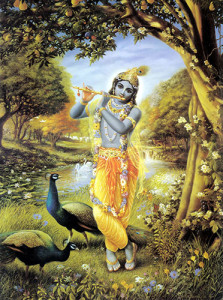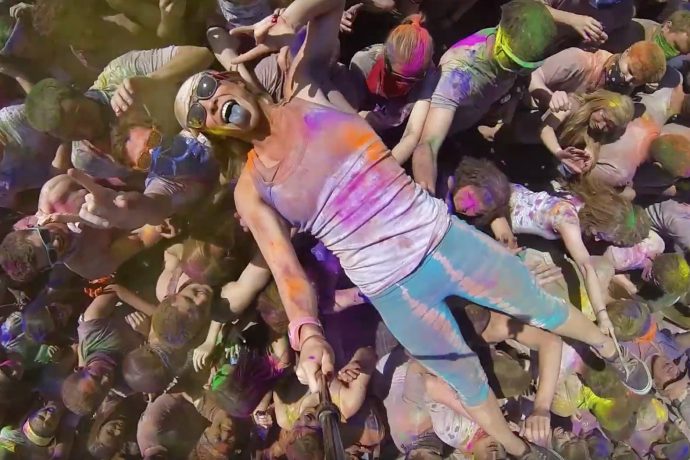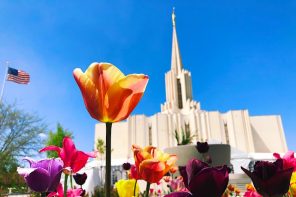This weekend, tens of thousands of people—primarily college age, overwhelmingly Mormon—will descend on the Sri Sri Radha Krishna Temple of Spanish Fork, Utah.
Sponsored and led by a priest affiliated with the International Society for Krishna Consciousness, (ISKCON, the so-called Hare Krishnas), the “Festival of Colors” is popularly known as “BYU’s unofficial spring break.”
Last year, for the twentieth anniversary of the festival, 80,000 people were reportedly in attendance, with that crowd estimated to be about 90% Mormon. The festival in Spanish Fork has spawned a series of smaller events in other cities run by a travelling team from the Utah temple and has also given birth to the popular “Color Run” phenomenon, employing the same kind of powdered, cornstarch-based colors, and the same spirit of carnivalesque engagement in “sharing love.”
Mormon festival-goers are led in chanting Sanskrit mantras and instructed in the metaphysical ramifications of such chanting. They are lectured on vegetarianism, on the true nature of knowledge and reality and the self, and invited to participate in the burning in effigy of a demonic “witch.”
They will throw “colors” made from biodegradable powder that billows out as great plumes, and they will smear and smack and rub such colors on fellow festival-goers, with whom they will dance and whom they will frequently be enjoined to hug—all expressions of love, explicitly interpreted by the organizers as manifestations of the ultimate model of love, Krishna.
For the Festival of Colors is unapologetic in its apologetics: it is a party for and of God, a God who has and does take many forms but who is most accurately and accessibly represented in the form of Krishna.

Lord Krishna playing the flute: “As drops of ocean water have the ocean’s qualities in minute degree, our forms and personalities are infinitesimal samples of the infinite Supreme Person.”
Krishna, moreover, is understood as present in the mantras the crowd is encouraged to chant, The chanting and singing—kirtan, the performance of musical worship within ISKCON—is “what drives us” to hold the Festival in Spanish Fork and around the country, said founder Kirtan is the reason for the Festival, Das has said in an interview: “to hear the names of God melodiously and repetively chanted for hours at a time, and to participate in the chant.”
That those who chant are not devotees—are not believers, may not even understand the words, may even (as I have witnessed) chant them in a mocking and distancing manner—does not matter to Festival organizers because it makes no difference; rather, they believe that only good can come from engagement, regardless of intention, with these sounds.
All those who speak from the multiple stages of the Festival between musical performances are explicit about the metaphysics of chanting and explicit about the religious nature, therefore, of not only the Festival but also Festival participation. And while Das may urge the crowd to take the “knowledge” he offers them “in a nonsectarian spirit,” he nonetheless compares his position to that of a Mormon missionary, offering his gospel to those who have not yet accepted the truth.
Despite explicit and emphatic reiteration of the metaphysics believed to be at play in the acts and the theology upon which such metaphysics are predicated, the Festival of Colors remains a popular event for Mormons. How such distinctly non-Mormon religious practice can be understood as—and commodified as—wholesome entertainment with a dash of cultural education for Mormons makes the Festival of Colors a fascinating case for the study of religion.
Not only does the Festival of Colors illustrate the simplicity and thus limits of traditional categorical divides between, say, “commerce” and “ritual,” “religion” and “entertainment,” it also complicates conceptions of religious practice itself, particularly “proselytization.”
The Festival of Colors, to pass “the Mormon test,” relies both on a sense of Mormonism’s exclusive truth claims and a model of universalism in which all human cultures are worthy of appreciation—even as the “religions” associated with these cultures are understood as false. From the point of view of the organizers, the Festival is a success—it passes, one might say, the ISCKON test—due to a parallel model of ultimately exclusive universalism that actively rejects any recognition of its exclusivity, a set of truth claims about God and reality that are presumed to be factual and natural and at play regardless of belief.
Simply put, the organizers understand everyone at the Festival to be praising Krishna, while the majority of the Festival goers understand themselves to be at a fun dance party where they’re being exposed to elements of another (“Indian,” “Hindu,” “Eastern,” “Asian”) culture.
The organizers are utterly explicit about their mission. Das told the crowd in 2015 that they were at the Festival to “glorify and honor the Supreme Being,” and, switching to a more American vernacular, declared that the Festival was “a revival!” For him, Krishna is the universal deity, the Godhead’s most accurate and accessible form. All the scriptures of the world’s great religions contain truth, he says, but the superseding scripture is the Bhagavad Gita just as the superseding representation of God is as Krishna.
Krishna is “the same God as in the Old Testament,” Das preaches, but without the jealousy and wrath, without “the terrible swift sword.” As he puts it, Krishna is a God familiar already to Festival goes, but as Krishna “he’s in a much better mood.”
Such theology—like the metaphysics of kirtan or teachings about the dangers of meat-eating and the true nature of the self—is, Das argues, not doctrine, not “religion” in the commonly used sense. As he compares himself to Mormon missionaries, he points to some parallel with Mormonism’s founding prophet, Joseph Smith, saying that he surely did not “come to start Mormonism” but “to break down the walls” of hypocrisy and exclusivity. “A lover of God is… inclusive,” Das insists, which is why Krishna descended, “to kill the hypocrites,” to liberate humanity from the strictures of religion and to raise consciousness to a higher level, such that those old strictures would become obsolete and extinct.
The truth offered by the Festival of Colors is a truth presented as fact, as natural, as always already the ways things are. You should accept it. Your life will be better if you do. But you are living it to some degree regardless. This is not a universalism that embraces all beliefs, but a universalism that—via an exclusive interpretation—coopts other beliefs under its name. And not a literal name, for Caru likewise eschews labels, dismissing both “ISKCON” and “Hinduism,” preferring to speak in the much broader register of “love,” albeit a love mediated by Krishna’s divinity.
And all those Mormon kids tossing colors into the air, practicing yoga postures, reciting mantras, getting their palms read, and perusing copies of the Bhagavad Gita for sale by robed mendicants?
For them—based on written reflections of past participants and an anecdotal sampling of attendees via interviews conducted at the 2015 Festival—this is a celebration of a very different universal God, a Christian deity in whose creation difference is ultimately a marker of sameness. Race, ethnicity, culture—these, within a Mormon perspective, are all aspects of humanity to be sampled and celebrated, but they are cosmetic—not cosmic—differences.
Chanting is no more metaphysical than cuisine, national costume, or language—all things the kids dancing on the lawn of the Sri Sri Radha Krishna Temple will likely encounter first hand in the course of their global mission work.
To Mormon participants, then, the Festival is less “a revival” than “a rock concert with spiritual influences.” It is not understood to be “transformative” in the cosmic, metaphysical manner Das believes it to be, but merely in the social sense of bridging distance between cultures.
Religion isn’t being done because the “religious” elements here aren’t real, aren’t true—what’s happening, instead, is a demonstration of culture and, through that experience of difference, a celebration of a shared sense of universalism.
As one local college student put it, at the Festival of Colors, “everyone is just the same,”except, when it comes to understanding of what the Festival is, what it does, and what it means, this might not be precisely true.
______
The author was part of a group of scholars researching and conducting interviews at the Festival of Colors in 2015 through the University of California’s “Religions in Diaspora and Global Affairs” initiative, sponsored in part by the Henry R. Luce Foundation.





